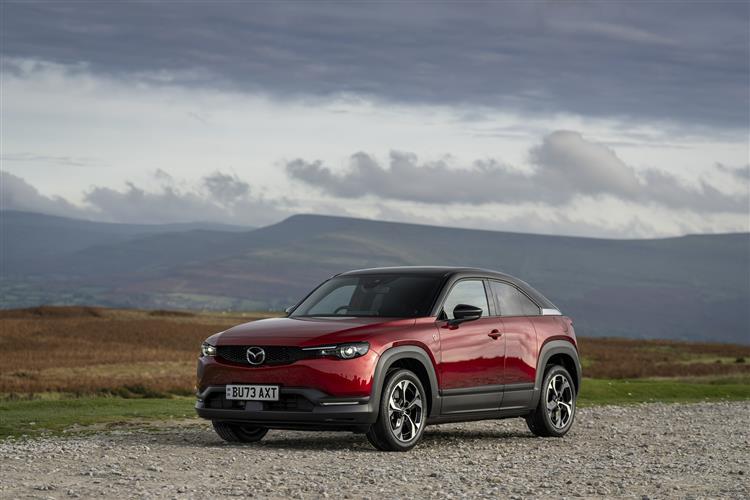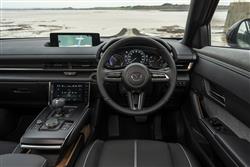R YOU READY FOR THIS ? (some text hidden) --NONE--
By Jonathan Crouch
Mazda's clever little MX-30 e-Skyactiv R-EV is a PHEV, but not as you know it. Jonathan Crouch drives it.
Ten Second Reviewword count: 36
Mazda's little MX-30 e-Skyactiv R-EV is a Plug-in Hybrid, but a very different one. The rotary engine's unique, never drives the wheels and constantly defers to an electric motor offering 53 miles of range. Sounds promising.
Backgroundword count: 169
It's been a very long time since we've seen a Mazda with a rotary engine, that Wankel technology inextricably linked with the brand, who produced more than 2 million rotary engines between the launch of the Mazda Cosmo in 1967 and the end of production of the RX-8 sports car in 2012. Since then, rotary tech's been absent from the company's line-up, but now it's back, not in a high performance coupe but in a model we'd previously thought was an EV, the little MX-30 hatch. The MX-30 e-Skyactiv R-EV is effectively the range extender version of that car. That's a description which might conjure up memories of the old BMW i3 range extender model, which had a rather crude little motorbike engine stacked out back to noisily cut in when the EV batteries were depleted. As we'll see, Mazda's R-EV tech is a great deal more sophisticated than that. In fact, the rotary engine it uses never directly powers the wheels. Sounds intriguing. Let's take a closer look.
Driving Experienceword count: 220
We quite liked the ordinary full-electric MX-30 when we first tried it, but wondered who would live with a real-world driving range figure of not much more than 100 miles (official figure 124 miles). This R-EV Plug-in Hybrid version seems a much better all-round proposition, it's 17.8kWh battery pack offering 53 miles of pure EV mileage before a little single-rotor 830cc 73bhp rotary Wankel petrol engine pipes in and adds a further 320 miles of range. Rather like Nissan's e-Power system (though that can't be plugged in), the engine isn't there to directly power the wheels. Instead via a generator, its role is to create energy for the 168bhp electric motor which (aided by 260Nm of torque) ultimately powers the car. There are three selectable driving modes - 'Normal', 'EV' and 'Charge'. 'Normal' uses the electric motor alone and keeps the rotary engine switched off unless battery charge becomes low. 'EV' mode forces the car to keep the engine switched off for even longer; and 'Charge' merely uses the engine to (rather inefficiently) charge the battery - you can set a target charge level in 10% increments. Regardless of which drive mode you choose, top speed is limited to an extremely modest 86mph, but 62mph is dispatched in a rather more eager 9.1 seconds, fractionally faster than the full-EV model.
To see the full road test text contact us on 0330 0020 227
Pictures (high res disabled)

.jpg)
|
.jpg)
|
.jpg)
| |||
.jpg)
|
.jpg)
|
.jpg)
| |||
.jpg)
|
.jpg)
|

|
Statistics (subset of data only)
Min |
Max |
|
Price: |
£34,750.00 (At 26 Mar 2024, Prime-Line) |
£39,050.00 (At 26 Mar 2024, Makoto) |
CO2 (g/km): |
21 |
|
Max Speed (mph): |
87 |
|
0-62 mph (s): |
9.1 |
|
Combined Mpg: |
283 |
|
Length (mm): |
4395 |
|
Width (mm): |
1795 |
|
Height (mm): |
1570 |
|
Boot Capacity (l): |
350 |
|
Scoring (subset of scores)
Category: Hybrid, Plug-in, Electric & Hydrogen
| Performance | |
| Handling | |
| Comfort | |
| Space | |
| Styling, Build, Value, Equipment, Depreciation, Handling, Insurance and Total scores are available with our full data feed. | |



